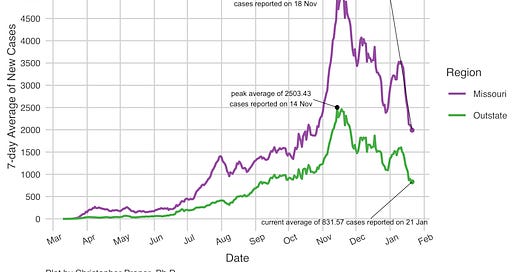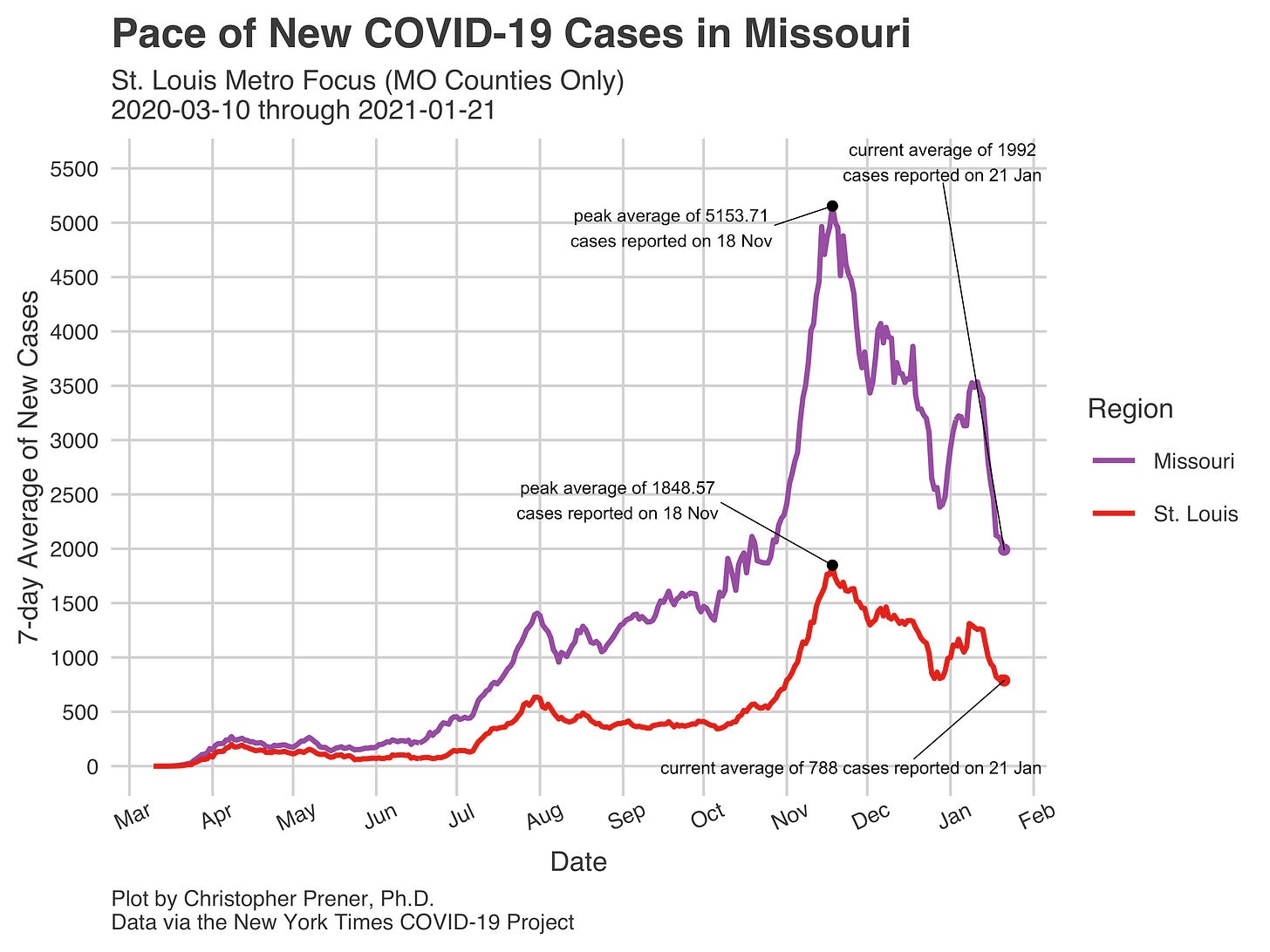Happy Friday, and welcome to the latest issue of “River City Data”! The interview returns tonight with friend-of-the-newsletter, Tim Wiemken, Ph.D., returning to give an update on some key questions related to the COVID-19 vaccine. I’ve also got an update on where we stand in Missouri with cases, testing, and vaccinations. - Chris
COVID-19 by the Numbers
Total cases in MO: 476,262 (+11,331 from last Friday)
7-day average of new cases per day in MO: 1,992 (-811 from last Friday)
Counties with the highest per capita rates of new cases per day this past week:
Ozark (68.06 per 100,000), Dade (63.99), Sullivan (58.8), Adair (55.28), Harrison (55.11), Clark (54.62), Boone (52.28), and Macon (51.51)
Total deaths in MO: 6,909 (+290 from last Friday)
7-day average of new deaths per day in MO: 45.57 (-3.43 from last Friday)
These numbers are current as of Thursday, January 21st. Additional statistics, maps, and plots are available on my COVID-19 tracking site.
Summary for the Week Ending January 22nd
We’re in the midst of a significant drop in the volume of new cases statewide in Missouri, in the three major regions I track, every metropolitan area, and most counties. The shift statewide and “outstate” is striking:
It is just as striking regionally. Southeast Missouri (the “Bootheel”) has been a particularly hard-hit area of the state, showing up on my maps and plots as an area of concern since April. But, take a look at the decreases being experienced there right now, especially in Mississippi, New Madrid, and Scott counties:
These downward trends represent the best news of the week. Even the counties with the highest per capita rates are seeing numbers of new cases well below what previously counted as a high. They’re concentrated in northern Missouri, the Ozark Mountains, and around Springfield.
The problem hanging over all this is that we have reason to believe that these data are missing a crucial piece - the growing share of antigen tests that are coming back positive and not being subsequently confirmed with a PCR test. First, definitions - antigen tests are the newer “rapid” tests while PCR tests have been widely used since last Spring.
Michele Munz at the St. Louis Post-Dispatch has some critical reporting on these tests, first published online last night. She confirmed that Missouri is still not including antigen tests when it accounts for positive cases. Since these are a growing share of tests, nearly 30% of those administered, understanding how this impacts our understanding of the extent of infections is critical.
I was able to look at the data before the Post-Dispatch’s story came out, using a data set that had been de-duplicated so that tests with a PCR follow-up have been removed. What I saw largely confirmed the thoughts I shared on Twitter this past Tuesday. Antigen tests without PCR follow-up are a growing share of positive tests - now, about 20% of positives are identified daily.
The biggest question for me on Tuesday was whether the antigen tests change our overall sense of the trajectory of COVID-19 in Missouri. By trajectory, I mean the shape of the trends in this plot:
The good news here is that the trend remains quite similar after adding these “probable” positives from antigen tests. November is still the peak of cases, and there are still bumps in new cases after Thanksgiving and Christmas.
What changes when we add the antigen test results is the number of new cases daily, especially after Thanksgiving and into early January. Without the antigen tests, our cases during the last six or seven weeks are biased downward by hundreds of positives per day. Given that, the magnitude of the drop in late December is most likely exaggerated, and the size of the post-Christmas bump is understated. The same is true of the current decline, which does not get our 7-day average down below 2,000 cases per day once the antigen tests are factored in.
I hope that Missouri begins reporting probable cases as soon as possible. Not including them increases the uncertainty that we have to treat case counts with. It is great news that their data systems can de-duplicate results from people who get a follow-up PCR test. However, what is crucial is that they start reporting at the county level and not just at the state level. I suspect, but can’t demonstrate, that antigen tests are concentrated in just a portion of Missouri’s counties. So numbers in New Madrid County, say, maybe far less skewed by this than in St. Louis City or County.
I want to draw attention to another data point - the Missouri vaccine rollout. The New York Times has a tracker that shows that only Nevada, the U.S. Virgin Islands, Guam, and Micronesia have vaccinated smaller shares of their population than Missouri. This is a dismal standing. Even when we look at the percent of dosages administered, Missouri’s 43% still places us towards the back of the pack. This absolutely needs to change.
In the Weeds
One major concern right now is the accuracy of polling in the United States. This recent Pew Research article on the “American Trends Panel” has a great breakdown of polling issues and how Pew is responding. It also has some fascinating details on religious affiliation, religious attendance, and religious practice in the United States. These data are critical because the U.S. Census Bureau does not regularly collect religious data.
Weekly Interview
Timothy Wiemken, Ph.D., is a colleague of mine from SLU. He’s an epidemiologist focusing on infectious disease and a faculty member in the SLU School of Medicine’s Division of Infectious Diseases, Allergy and Immunology. Tim’s first interview with “River City Data” was way back in my first issue. You can follow him on Twitter.
CP: Can you share your perspective on how the vaccine roll-out is going right now both nationally and in Missouri?
TW: In general, it has been pretty disheartening to see the vaccine rollout both nationally and locally. It is a hot mess for lack of a better phrase. The lack of transparency of how many doses are available, how many are purchased/coming, time frames for distribution, access, - really everything has been a complete and utter mess. There are plenty of reports of people lying about their demographics and risk factors to jump the line - and it works since no one is able to really verify anything. For example, if I said I had one of the risk factors that put me ahead of my actual phase, who could possibly verify this? It is just not possible given the makeup of our health systems and lack of data availability.
Aside from that, we have two vaccines potentially available, Pfizer/BioNTech and Moderna. Pfizer is very difficult to transport and store given the need for ultra-cold storage (freezers are not readily available in most areas for this level of storage), where Moderna is much easier with typical freezer temperatures. However, it is unclear as to how much vaccine is available, shipped, and waiting to be shipped. Without this knowledge, localities cannot effectively plan distribution and provision. This was underscored by the recent federal discussions of releasing the stockpile being held back to ensure 2nd doses – and then indicating that those doses didn’t actually exist. IF those with the vaccine don’t even know what is available how are localities far downstream from these groups supposed to know what is happening?
Beyond this, it is unclear as to where folks can actually get vaccines. Since this is supposedly a state-by-state distribution, there is a lot of confusion as to if someone who lives in St. Louis County can get a vaccine in St. Louis City, or elsewhere – since they both have different sign-up forms. Communication across jurisdictions from a health perspective has proven elusive, as we have seen throughout this pandemic and no one really knows what to expect. Obviously, I’m not here to blame any local response – particularly since the defunding of public health over the past 25 years has left shoestring budgets with minimal assistance federally – and the fact that this is a once in hundred years’ pandemic… for now. A federal response was needed from the outset that was consistent and clear for every jurisdiction. Our current approach of everyone trying their best with their limited resources cannot be successful everywhere.
CP: There have been reports of allergic reactions to the vaccine. Can you put that in context - what is going on there?
TW: Definitely. There are always reactions to any medication (vaccines being a medication as well – just a preventative medication versus one to reduce symptoms). The reactions reported for the available vaccines under emergency use (Pfizer and Moderna) have been severe but treatable – mainly anaphylaxis. This is why you are asked to stay for ~15 minutes (>70% of reactions happen within 15 minutes) in the office post-vaccine so they can treat you if any reactions occur (you will know, trust me). Treatment is easy and effective when you catch it (Epi-pen). Most of the cases have had a documented history of anaphylaxis to something else, so if you have had anaphylaxis to something before, definitely tell the office before your vaccine so they can watch you carefully.
To put this more in perspective, the CDC report on anaphylaxis for Pfizer vaccine evaluated the first ~2 million doses given. Of these nearly 2 million doses, there were only 21 cases of anaphylaxis. This is about 1 case per every 100,000 injections (or 0.001%). The population of St. Louis city is around 300,000, so if EVERYONE in the city was vaccinated, there might be 3 cases of anaphylaxis. That isn’t much. The Asthma and Allergy Foundation of America reports anaphylaxis rates in the US to be about 1 in 20 people. This is quite a bit more common to get this reaction from a peanut allergy, bee sting, or some other environmental factor.
We do not have good data on allergic reactions to most vaccines as vaccines and mediations are not usually as highly scrutinized as the COVID-19 vaccines. Some reports suggest about a case per million anaphylaxes from the flu vaccine, which is lower than for the COVID vaccines - but again, I do not see these as comparable since and adverse event reporting is voluntary and generally poor in the USA.
CP: And finally, what is the most important message we need to be hearing about the vaccine right now?
TW: Get it as soon as you can.
There are always some risks with anything you do – be it the bacon you ate for breakfast, the fact you binge-watched a Netflix show on the couch instead of exercising, the 20 ibuprofen you took for your back pain, the unregulated vitamins you take daily, etc. These vaccines are unquestionably the most highly dissected medications ever used in humans. They are safe. There were no corners cut in their study– the studies were sound – they were conducted by scientists (like those at SLU!) and not just pharmaceutical companies (even though pharmaceutical companies are full of very good scientists too!). Most importantly, they work… for now.
If we don’t continue to protect each other through basic infection prevention interventions such as hand hygiene, environmental disinfection, mask use, and getting vaccinated as quickly as possible, we continue to play a cat and mouse game waiting for a variant to pop up that evades the antibodies created by our current vaccines. If that happens, we are right back to March/April 2020… it would be tough to believe anyone wants that. Any variant that evades our immunity will cause repeat infections, so at that point, it won’t matter if you have been infected before or had a vaccine – you will be at risk again.
If you like what you see here and don’t already, please subscribe!






